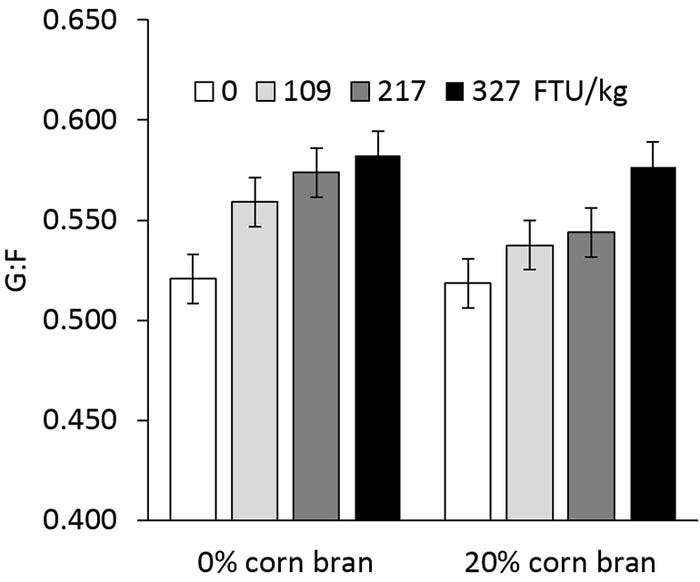Does fiber affect phytase in the swine diet?
Results clearly show a positive response to phytase addition regarding average daily gain, feed efficiency and bone mineralization.
August 2, 2018

By Jesus Acosta, Iowa State University Department of Animal Science Ph.D. student; and John F. Patience, Iowa State University Department of Animal Science Professor
Generally, high-fiber ingredients have the potential to lower diet cost. However, nutritionists proceed with caution as fiber can affect the production outcomes in different ways. For example, fiber reduces carcass yield, so that performance measured on a live weight basis may lead to different conclusions than if performance is measured on a carcass basis. Fiber is also known to alter the environment in the gastrointestinal tract impacting the rate of passage as well as the pig’s susceptibility to gastrointestinal disease — either positively or negatively.
Adding fibrous ingredients to diets reduces digestibility of energy, amino acids and possibly other nutrients as well. Some of these effects, specifically the ones related to the gastrointestinal tract, suggest that fiber could affect phytase
Phytase is added to swine rations to release digestible phosphorus from phytate — an indigestible source of phosphorus found in plants. Although a mechanism of fiber and phytase interaction is unclear, we wonder about two possibilities. First, by increasing the rate at which food passes through the intestinal tract, phytase would have less time to interact with phytate; it is generally accepted that all enzymes added to diets would be more effective if they had more time to interact with the digesta. Therefore, increasing rate of passage, which fiber can do, would not be a good thing. Secondly, fiber can delay the enzyme-substrate interaction by trapping nutrients within their structure and reducing access to them by the enzyme.
As a first step, instead of testing these mechanisms directly, we considered it important to determine if these potential effects are actually impacting production outcomes. We designed an experiment to determine if phytase is affected by the addition of insoluble fiber — the kind of fiber found in corn, corn bran and corn distiller’s dried grains with solubles. In this study, 480 newly weaned pigs received one of eight different dietary treatments: corn-soybean meal-based diets with four levels of added phytase (0, 109, 218 and 327 phytase unit [FTU] per kilogram) or other diets based on corn, soybean meal and 20% bran with the same four levels of added phytase (0, 109, 218 and 327 FTU/kg). All diets were deficient in phosphorus to allow us to see how the pig responded to added phytase. The four levels of phytase were expected to meet either 46, 60, 75 and 88% of the pig’s phosphorus requirement in the corn-soybean meal diet and 41, 55, 69 and 83% of the phosphorus requirement in the diets containing corn bran.
The results clearly show a positive response to phytase addition regarding average daily gain, feed efficiency and bone mineralization. This is important because it supports the role of phytase in helping to meet the phosphorus requirement. On the other hand, the addition of fiber decreased ADG and tended to decrease feed efficiency; these results are typical of what happens when lower energy diets are fed to weanling pigs.
Finally, results of this experiment suggest that insoluble fiber does not adversely influence the ability of the phytase enzyme to do its job. The figures below show how the pigs responded to added phytase. It was basically the same, whether the pigs received the lower or higher fiber diet. As more phytase was added to the diets, ADG, average daily feed intake, gain: feed and bone ash increased. The data are not quite as clean for ADFI in the 20% bran diet, but otherwise, the trends are very clear and consistent.

Figure 1: Impact of phytase, fiber and their interaction on ADG; enzyme P < 0.001, fiber P = 0.032 and enzyme × fiber P = 0.1937

Figure 2: Impact of phytase, fiber and their interaction on ADFI; enzyme P = 0.381, fiber P = 0.632 and enzyme × fiber P = 0.840.

Figure 3: Impact of phytase, fiber and their interaction on G:F; enzyme P < 0.001, fiber P = 0.097 and enzyme × fiber P = 0.6413.

Figure 4: Impact of phytase, fiber and their interaction on bone ash percentage; enzyme P = 0.005, fiber P = 0.949 and enzyme × fiber P = 0.999.
You May Also Like



